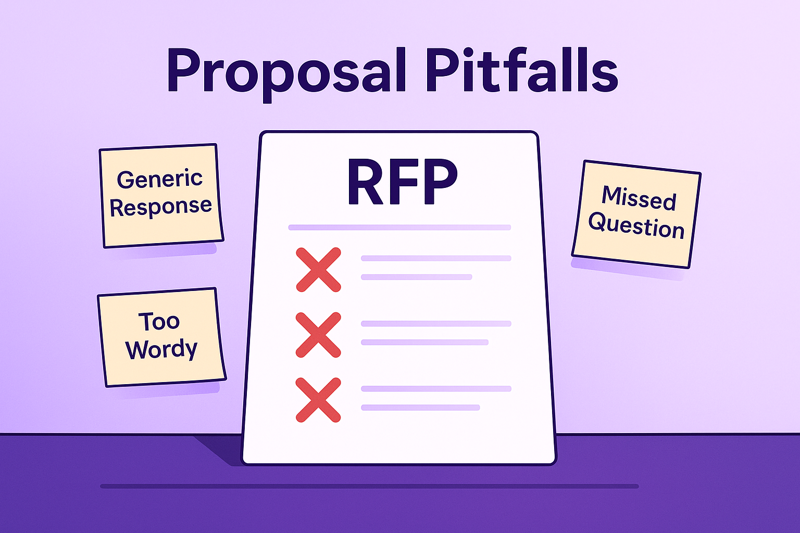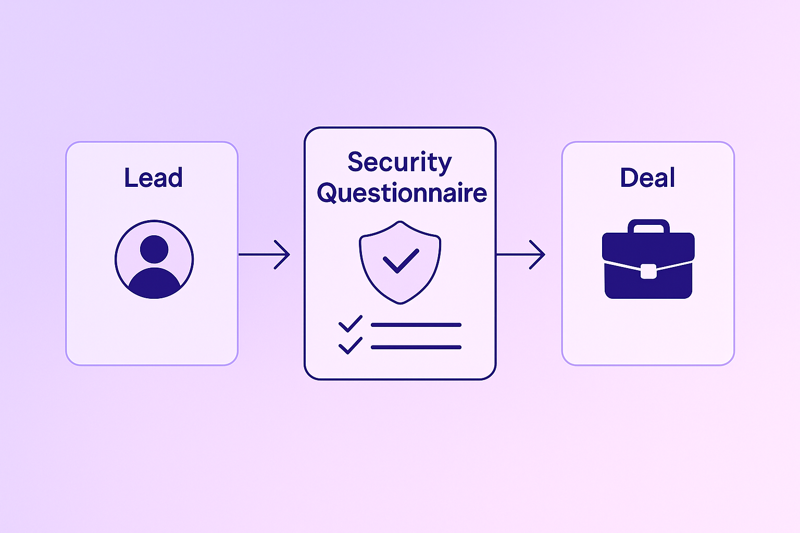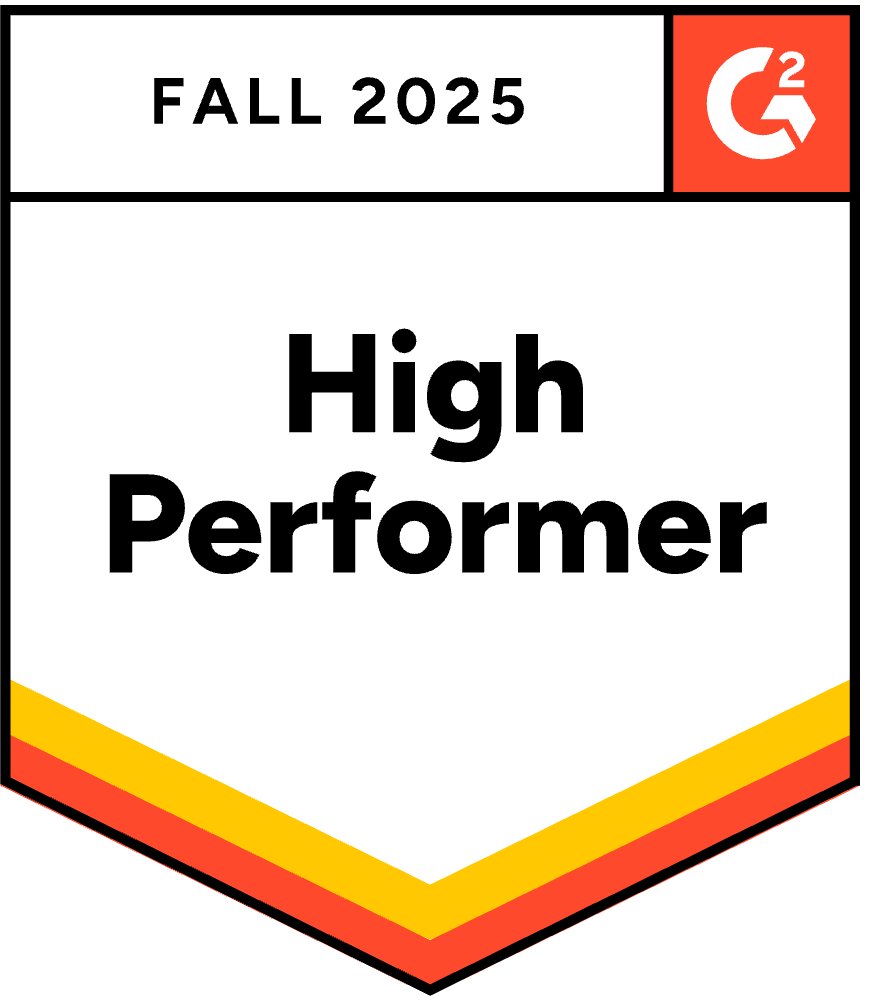5 RFP Response Mistakes Killing Your Win Rate
August 6, 2025
By
Evie Secilmis

Common Mistakes That Lower RFP Win Rates (and How to Fix Them)
Improving your RFP win rate is one of the most impactful ways to grow your business — but it requires more than just submitting more proposals. It demands strategy, consistency, and precision.
Before diving into the common mistakes that can lower your RFP success rate, let’s first define what an RFP win rate actually means and why it matters.
What Is an RFP Win Rate?
Your RFP win rate is the percentage of proposals your team submits that result in a contract award. It’s a key performance metric that reflects how effectively your proposals resonate with clients and meet their needs.
Tracking your win rate over time helps you identify patterns, allocate resources strategically, and uncover areas for improvement.
If you’re new to RFPs, read RFP 101: What Is a Request for Proposal? to understand how proposals are structured and evaluated.
A “good” RFP win rate varies by industry, but a general benchmark is:
- 50% or higher: strong and competitive
- 30–40%: respectable in highly competitive markets
Benchmarking against your peers and analyzing historical performance allows you to set realistic targets and measure progress accurately.
For a deeper dive into measuring and improving this metric, check out Maximizing Your RFP Win Rate: Strategies for Success.
1. Failing to Understand the Client’s True Needs
One of the biggest mistakes in RFP responses is focusing on your solution before understanding the client’s problem.
RFPs are not just about showcasing what you can do — they’re about proving you understand the client’s goals, challenges, and priorities.
How to Fix It:
- Conduct Thorough Research: Go beyond the RFP document. Research the client’s industry, recent news, and pain points. Understanding their context helps you craft a more relevant proposal.
- Customize Your Approach: Use language that mirrors the client’s objectives and demonstrate how your solution directly addresses their needs.
When clients feel understood, they’re far more likely to trust your proposal.
2. Submitting Generic, Recycled Proposals
Clients can tell when you’ve reused content. Generic proposals fail to connect and make your response look lazy or disinterested.
Personalization shows commitment and effort — two traits that build confidence and trust.
How to Fix It:
- Tailor Every Proposal: Reference the client’s organization by name, mention their goals, and highlight how your solution aligns with their strategic vision.
- Use the Client’s Language: Match tone and terminology from the RFP. It shows you’re paying attention and understand their world.
For tips on writing more compelling, client-focused proposals, revisit Maximizing Your RFP Win Rate: Strategies for Success.
3. Ignoring RFP Requirements
Failing to follow RFP instructions — such as formatting rules, page limits, or submission deadlines — can get your proposal disqualified instantly.
Even a small oversight signals carelessness and a lack of attention to detail.
How to Fix It:
- Read Carefully: Highlight mandatory requirements and ensure each is addressed.
- Create a Compliance Checklist: Track deliverables and verify all instructions have been followed before submission.
Adhering to the RFP format isn’t just about compliance — it’s about demonstrating respect for the client’s process and professionalism.
4. Overloading the Proposal with Irrelevant Information
Including every possible detail may seem thorough, but it can dilute your message. Evaluators typically skim dozens of responses — clarity and conciseness win every time.
How to Fix It:
- Focus on Relevance: Stick to the client’s requested information and eliminate filler content.
- Use Clean Formatting: Break up text with subheadings, bullet points, and visuals to improve readability.
Think of your proposal as a story — each sentence should move the client closer to choosing you.
5. Weak Visual Design and Formatting
Even strong content can fall flat if your proposal looks cluttered or inconsistent. A poorly designed proposal makes your company appear disorganized and unprofessional.
How to Fix It:
- Use a Clean, Professional Design: Consistent branding, spacing, and typography enhance readability.
- Incorporate Visual Aids: Charts, infographics, and visuals can make complex data more digestible.
Presentation matters — it communicates your attention to detail before evaluators even read a word.
6. Neglecting Pre-RFP Relationship Building
One of the most overlooked opportunities to improve your win rate happens before the RFP is even released.
Building rapport with potential clients early allows you to shape your message and position your company as a trusted partner rather than just another bidder.
How to Fix It:
- Engage Early: Attend industry events, webinars, and networking sessions where your target clients are active.
- Stay Connected: Follow clients on LinkedIn, engage with their content, and share thought leadership that aligns with their priorities.
By the time the RFP goes live, your company should already be on their radar.
7. Not Leveraging Technology
Manual RFP management can be slow, inconsistent, and error-prone. Automation tools can help teams respond faster, maintain content accuracy, and improve collaboration.
How to Fix It:
- Use Proposal Software: Platforms like Iris streamline RFP responses with content libraries, AI-driven insights, and compliance tracking.
- Integrate with CRM Systems: Keep a record of client preferences and proposal history to personalize responses at scale.
Explore how automation supports consistency and efficiency in What Is Proposal Automation (and Why It Matters).
8. Failing to Review and Learn from Past Proposals
Many teams move from one RFP to the next without reflecting on what worked or what didn’t. Skipping this analysis means you’ll repeat the same mistakes.
How to Fix It:
- Conduct Win/Loss Reviews: After each proposal, document insights on what contributed to the outcome.
- Provide Ongoing Training: Regular workshops or review sessions help teams sharpen their RFP writing skills.
Continuous improvement transforms your RFP process from reactive to strategic — the foundation for long-term success.
Key Takeaways
Improving your RFP win rate takes more than quick fixes — it requires a commitment to strategy, research, and refinement.
✅ Understand each client’s unique needs
✅ Personalize every proposal
✅ Follow all RFP requirements
✅ Maintain professional design and structure
✅ Use technology to increase efficiency
✅ Review and learn from every submission
By avoiding these common mistakes and applying the best practices outlined in Maximizing Your RFP Win Rate: Strategies for Success, your team can craft smarter, sharper proposals that close more deals.
Share this post
Link copied!



















